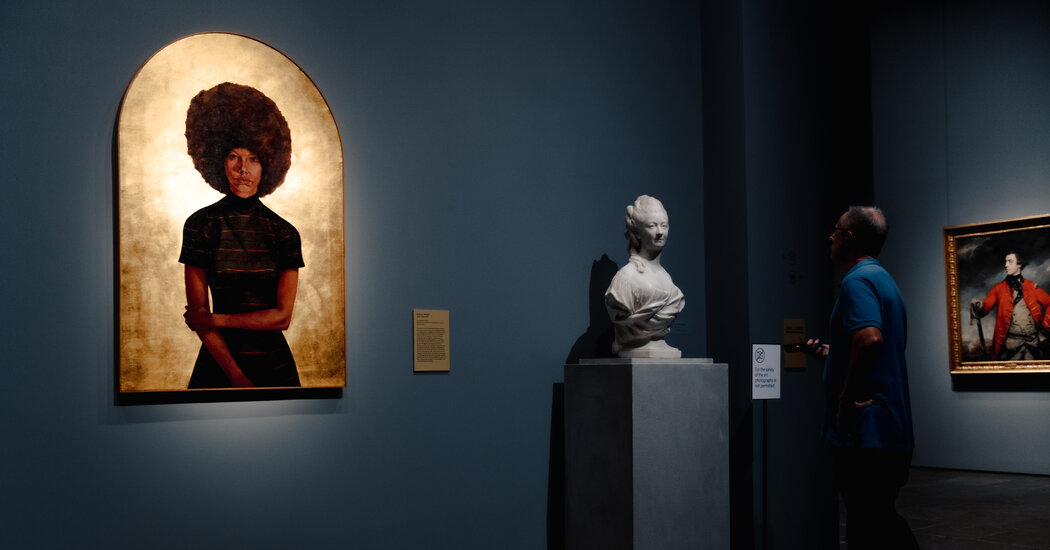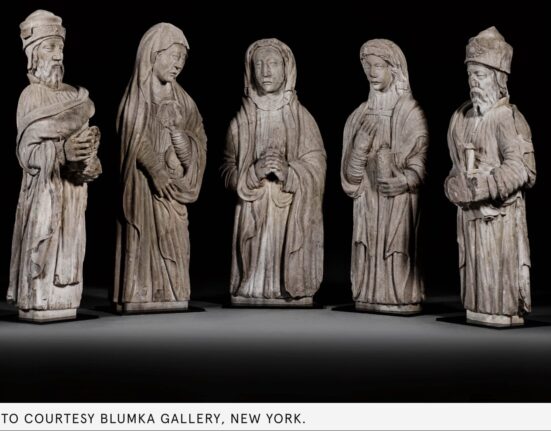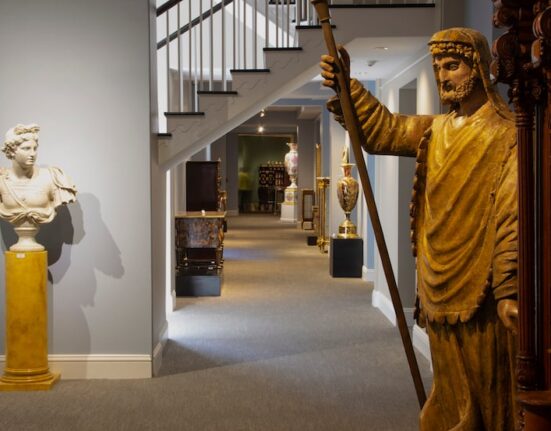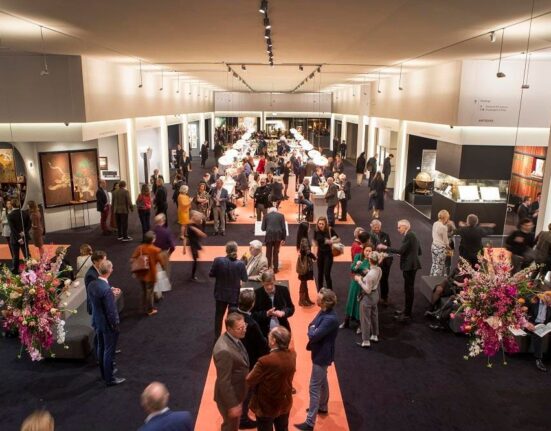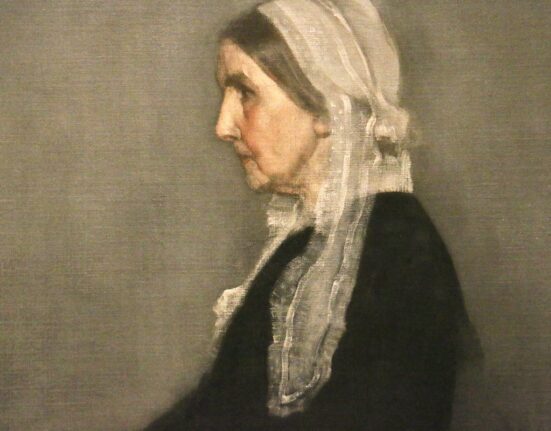One day, in the late 1970s, while walking the streets of Pigalle in Paris, the American painter Barkley L. Hendricks noticed several well-dressed Black men and women. As Hendricks later explained, he was particularly struck by the fashion sense of two African men. He spent time photographing them in different postures and situations, as was his habit with models he painted, laying the foundation for work that would end up on his canvas. The resultant painting — “APB’s (Afro-Parisian-Brothers)” — is eternally modern even in our time, relentlessly cool, and luxuriously vibrant, qualities that radiate through his ongoing exhibition of portraits at the Frick, where he is the first artist of color to have a solo show in the museum’s 88 years of existence. It is a posthumous glory: Hendricks died in 2017, at age 72.
In 1966 — the year he turned 21 — Hendricks spent time in Europe funded by the Cresson scholarship at the Pennsylvania Academy of the Fine Arts, touring the continent’s cities, looking at and falling in love with the works of European masters like Van Dyck and Rembrandt. Back in the United States, he consistently visited the Frick, reportedly his favorite museum, studying the collection, which also included classic paintings by Bronzino and Moroni. Both at home and abroad he noticed the continuous absence of Black people in the portraits (the Frick, until now, has never displayed the portrait of a Black figure in its collection). The few he saw dealt with dehumanizing representations, mostly of enslavement or servitude. He decided to fill what he saw as a gaping hole, and leaning on his influences from European portraiture began to make elegant, poised paintings of Black people.
There are deliberate, delightful decisions surrounding the organization of the exhibition, “Barkley L. Hendricks: Portraits at the Frick.” The main elevator opens up to reveal “Lawdy Mama,” a luminous painting of a Black woman cleverly layered on gold leaf with an Afro sitting on her head like a halo, complementing the arched canvas (ideas that might have occurred to Hendricks after seeing Gentile da Fabriano’s “Madonna and Child with Saints Lawrence and Julian”).
Aimee Ng, who curated the show, together with Antwaun Sargent as consultant curator, wisely arranged the 14 pieces of Hendricks’s paintings between some of the European paintings from the Frick’s collection, sometimes matching paintings with similar colors intuitively across the rooms of the fourth floor of the Frick Madison, where the show is set, giving visitors a taste of what Hendricks might have been looking at when he frequented the museum. This collaboration with Sargent, who is a director at Gagosian — a multinational commercial gallery — might raise the question of whether there is a deliberate reconsideration of Hendricks’s place in the art market (one of his pieces in the show is for sale by the Jack Shainman Gallery, which represents him). In an interview, Ng, who is a specialist in Italian Renaissance painting, said she had asked Sargent what contemporary artists he thought might illuminate the Frick’s collection, which ends at 1900. She said he suggested Hendricks and given Sargent’s expertise in the subject, and the fact that he had maintained a relationship with the artist, he became her collaborator.
Hendricks’s rich treatment of color shines through the show, evident in his choices of backgrounds, displaying an intimate relationship with the materiality of clothing with great attention to how they fold or reflect light, and in minute detail like how he paints the fade of denims. (He is quoted on a wall text as having boasted, “No one paints jeans like me, with the consciousness of the fact that jeans are a material that is worn rather than painted.”)
Perhaps the most famous set in his experiments with different shades of the same color are his white-on-white paintings, in which he spectacularly layers shades of white in figurative paintings such as in the striking “October’s Gone … Goodnight” — depicting the same majestic figure of a woman in a white dress, standing, facing three different directions, or in “Lagos Ladies (Gbemi, Bisi, Niki, Christy),” painted after he visited Nigeria for the World Black Festival of Arts and Culture in 1977 and which before now has never been on view.
Yet, Hendricks’s mastery of the genre is reinforced by his understanding of the function of all great portraiture: to elucidate what the artist considers the grand persona of the subject, while simultaneously memorializing the version the artist wishes to commit to history.
Hints to these are present in some of the photographs in “Barkley L. Hendricks: Portraits at the Frick,” a monograph accompanying the exhibition. Drawn from Hendricks’s archive, the pictures demonstrate the original character of some of the figures and how Hendricks introduced little elements to change or accentuate their personalities: glasses for models that originally wore none, a change in hairstyle or a hat, an entire replacement of attires, addition or removal of jewelry, a toothpick to create an unforgettable, funky vibe. This intentionality with the personality of the figures he painted is perhaps most potent in “Woody.” Set on yellow canvas, a dancer in a yellow unitard romper stands on one foot with the other raised and arms spread out. There is no light falling on his face, and his eyes, darkened entirely, project a strange, irrepressible sense of balance and power.
The show exudes a deep relationship to art history, yet Hendricks, a notable pioneer of Black figurative painting in the United States, has not received enough recognition for his role as an inspiration and as a forerunner to many of today’s artists, including Kehinde Wiley, Toyin Ojih Odutola, and Njideka Akunyili Crosby, who have furthered the genre. Richard J. Powell, a professor of art & art History at Duke University and considered an authority in African American art history, writes in his catalog essay “Barkley L. Hendricks, Anew,” that “Every intermittent sighting of Barkley L. Hendricks’s work over the past few decades has been a revelation.” In this way, Hendricks seems to have maintained the position of an underground virtuoso who is always being discovered in bits and pieces. The show at the Frick seems to be, finally, a break into the atmosphere, introducing him to a new audience and solidifying his position in the canon and lineage of Black American portraiture.
In 1966, the same year Hendricks first traveled to Europe and began looking at European masters, the great Black American boxing champion Muhammad Ali was resisting being drafted into the U.S. Army to fight in Vietnam, the Black Panther Party was being formed, and the Black American civil rights activist and writer Malcolm X had just been assassinated barely a year earlier. It was a period of great racial and political upheaval, and most Black movements had to find strength in each other only, frowning heavily upon any kind of white or Western influences.
So, was it, in some way, an act of bravery that Hendricks stuck with the influences that mattered to him and helped expand his artistic vocabulary? Or was it a way of turning European modes of painting on its head by imbuing the form with an essence that was unmistakably Black? Regardless, what the indelible portraits at the Frick really portray is that art is a confluence of many rivers, and the greatest artists drink from them all.
Barkley L. Hendricks: Portraits at the Frick
Through Jan. 7, 2024 at the Frick Madison, 945 Madison Avenue, Manhattan, (212) 288-0700; frick.org.

